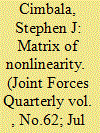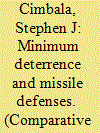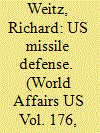|
|
|
Sort Order |
|
|
|
Items / Page
|
|
|
|
|
|
|
| Srl | Item |
| 1 |
ID:
158500


|
|
|
|
|
| Summary/Abstract |
Missile defenses have been bones of contention in past arms control negotiations as between the United States and Russia. The likelihood is that ballistic missile defenses (BMD) for protection of the U.S. homeland or for the defense of regional allies in Europe and elsewhere will be of greater interest in view of their maturing technologies and emerging regional threats. On the other hand, the deployment of next generation missile defenses is not an isolated issue. From the standpoint of nuclear deterrence, missile defenses are embedded within a larger framework of emerging technologies, including those for conventional prompt global strike, for cyber warfare, and for the modernization of offensive strategic nuclear forces.
|
|
|
|
|
|
|
|
|
|
|
|
|
|
|
|
| 2 |
ID:
121925


|
|
|
| 3 |
ID:
107579


|
|
|
|
|
| Publication |
2011.
|
| Summary/Abstract |
Ratification and entry into force of the New START agreement open the door for possible additional reductions in both states' numbers of deployed long-range nuclear weapons and launchers, but the matrix of post-New START agreement involves nonlinearities with respect to the relationship between minimum deterrence and missile defenses. NATO's Lisbon summit in 2010 invited Russia to participate in a European missile defense system, but Russia is wary of any theaterwide antimissile system that could grow into a more ambitious deterrent-denial force pointed at Russia. Minimum deterrence would drop the numbers of U.S. and Russian strategic nuclear weapons to 1,000 or fewer, but getting Moscow and Washington to move well below 1,000 would require parallel reductions and/or restraints on the part of other nuclear weapons states and a missile defense regime of "cooperative security" rather than mutual suspicion.
|
|
|
|
|
|
|
|
|
|
|
|
|
|
|
|
| 4 |
ID:
118665


|
|
|
|
|
| Publication |
2012.
|
| Summary/Abstract |
U.S.-Russian political relations took a turn for the worse in 2011-2012, especially in the latter year, a presidential election year in both the United States and Russia. Among the issues in contention as between Washington and Moscow was the American and NATO plan for phased deployment of missile defenses in Europe. Some prominent Russian officials and military experts regarded the proposed European Phased Adaptive Approach (EPAA) plan for European missile defenses as a prospective threat to Russia's strategic nuclear deterrent. Russia's objections to NATO's missiles defenses are as much political as they are military-technical, and the 2012 return of Vladimir Putin to the Russian presidency renders uncertain the future of the U.S.-Russian 'reset' launched during the early years of the Obama administration.
|
|
|
|
|
|
|
|
|
|
|
|
|
|
|
|
| 5 |
ID:
137281


|
|
|
|
|
| Summary/Abstract |
This study inquires whether the United States and Russia might be headed toward a new Cold War, at least with respect to certain aspects of their diplomatic-strategic behavior. Those aspects have to do with missile defenses, nuclear arms control, and conflict in cyberspace. Arguments pertinent to these three domains or issues are not necessarily transferable, as interpretations of trends in U.S.-Russian relations, to other aspects of their diplomacy and national security affairs. For example, one cannot necessarily infer the outcome of Russian-American relations over Syria, Ukraine, or Afghanistan based on prevailing tendencies in nuclear arms control or cyber war. Nevertheless, the examination of missile defenses, nuclear arms control, and cyber conflict may yield important insights about near- and longer term prospects, because: (1) each of these issues has been identified by both states as a matter of vital national security interest; (2), each issue offers a challenging mix of technical judgments and policy prescriptions; and (3) U.S.-Russian cooperation is a necessary condition for amelioration of the security risks in each of these issue domains, as well as in their possible areas of overlap.
|
|
|
|
|
|
|
|
|
|
|
|
|
|
|
|
| 6 |
ID:
095977


|
|
|
| 7 |
ID:
128039


|
|
|
|
|
| Publication |
2014.
|
| Summary/Abstract |
US nuclear deterrence and arms control policy may be moving, by design and by inadvertence, toward a posture of strategic "defensivism". Strategic "defensivism" emphasizes the overlapping and reinforcing impact of: (1) reductions in US, Russian and possibly other strategic nuclear forces, possibly down to the level of "minimum deterrence," (2) deployment of improved strategic and/or theater antimissile defenses for the US, NATO allies and other partners; and (3) additional reliance on conventional military forces for some missions hitherto preferentially assigned to nuclear weapons. This article deals with the first two of these aspects only: the interaction between missile defenses and offensive force reductions in US-Russian strategy and policy. The findings are that stable deterrence as between the USA and Russia is possible at lower than New Strategic Arms Reduction Treaty levels, but reductions below 1000 deployed long-range weapons for each state, toward a true minimum deterrent posture, will require multilateral as opposed to bilateral coordination of arms limitations. Missile defenses might provide some denial capability against light attacks by states with small arsenals, but they still fall short of meaningful damage limitation as between powers capable of massive nuclear strikes.
|
|
|
|
|
|
|
|
|
|
|
|
|
|
|
|
| 8 |
ID:
145153


|
|
|
|
|
| Summary/Abstract |
The United States and Russia, in the aftermath of Russia’s annexation of Crimea and destabilization of Ukraine, seem to have ditched entirely the “reset” in their political relations. Despite this odor of Cold War redux, there remain the opportunities and necessities for renewed attention to strategic nuclear arms control as between the two governments. US and NATO missile defenses as planned for European deployment figure into this equation, although in somewhat unpredictable ways, given technological uncertainties in existing and foreseeable defenses, as well as the possibility of improved delivery systems for offensive conventional or nuclear weapons.
|
|
|
|
|
|
|
|
|
|
|
|
|
|
|
|
| 9 |
ID:
122131


|
|
|
|
|
| Publication |
2013.
|
| Summary/Abstract |
In March 2013, US Secretary of Defense Chuck Hagel, citing the progress of North Korea's nuclear program, announced that the United States would be bolstering its missile defenses. Fourteen new ground-based interceptor missiles, known as GBIs, would be deployed to Alaska, augmenting the thirty already in silos there and in California. The Pentagon would develop a new two-stage GBI, as well as a more advanced version of the "kill vehicle," which interceptors carry to smash into adversary warheads ("hit-to-kill"). The Obama administration would be deploying a second advanced mobile radar system, the Army Navy/Transportable Radar Surveillance 2, in Japan. And Hagel even indicated that the administration would restructure its plans for US missile defenses in Europe, canceling the SM-3 IIB interceptor, the cornerstone of the fourth and final phase of its European Phased Adaptive Approach (EPAA), which had been announced in 2009 as a means of deploying more-advanced interceptors in Eastern and Central Europe specifically designed to defend the US homeland from intercontinental ballistic missiles launched from Europe, Eurasia, or the Middle East.
|
|
|
|
|
|
|
|
|
|
|
|
|
|
|
|
|
|
|
|
|